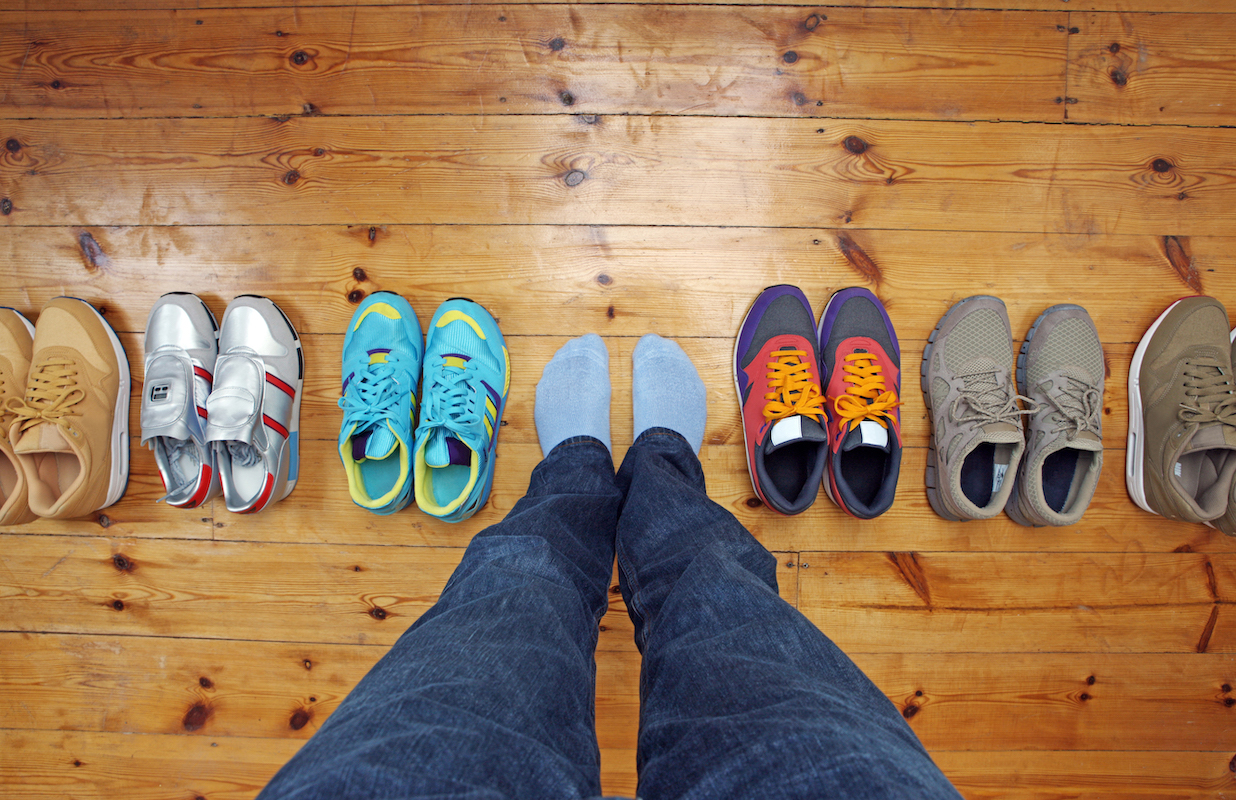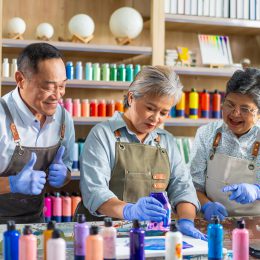5 Shoe Mistakes Many Older Adults Make
Your feet are the hardest–working part of your body, so they deserve to be treated well. Here’s exactly what that means.

The Whole-Body Wellness Challenge is rooted in the understanding that health isn’t just about fitness. This month, we’re sharing fun and easy ways to bring everything you love about SilverSneakers classes and your time at the gym to other areas of your life. You’ll find workouts, tips, and activities to help you build strength, eat healthier, sleep sounder, and be more present in your life, so you can feel good—body, mind, and spirit.
Your feet have been taking you where you want to go nearly every day of your life. But eventually, those decades of wear and tear are bound to take their toll. In fact, among people over the age of 65, foot pain ranks among the top 20 reasons for seeing a doctor, according to a study in the Journal of Foot and Ankle Research.
What’s more, many people have habits that can make foot discomfort worse. Here are five common mistakes people make when it comes to their feet—and what to do instead.
Mistake #1: You Wear Slippers Around the House
“Seniors often think they’re doing themselves a favor by wearing slippers, but slippers are basically the same as walking barefoot,” says podiatric surgeon Marlene Reid, D.P.M. She’s co-owner of Family Podiatry Center in Naperville, Illinois, and past president of both the Illinois Podiatric Medical Association and the American Association for Women Podiatrists.
“Podiatrists across the country have been seeing a ton more heel pain during the coronavirus pandemic because people have been home and walking around the house in slippers or no shoes at all,” she says.
Soft, fuzzy slippers may feel cozy, but they lack arch support, and if they’re mule style (with nothing securing them to your heel), they can come off easily, contributing to falls.
In a study published in Footwear Science, 765 men and women ages 70 and older were followed for about two years and asked to keep track of any falls that took place in their homes. Fifty-two percent of falls occurred when people were barefoot, wearing slippers, or wearing socks without shoes.
What does that mean for you? Wear athletic shoes at home. They have much more stability to help prevent heel pain, and the rubber soles can help prevent falls. Choose a pair with a wider toe box to give your toes space to spread out.
If you keep your home shoe-free to avoid tracking in dirt, purchase a pair of shoes that will be worn only inside.
Mistake #2: You Buy the Wrong Shoe for Your Foot Type
There are three different foot types: normal, high arch, and flat-footed. Each has its own shoe requirements to achieve healthy, happy feet. (Not sure what type of foot you have? Ask a podiatrist for an assessment. You can find DIY tests online, but they aren’t always accurate, Dr. Reid says.)
Once you know your type, here’s how to shop accordingly:
If your foot type is normal, also called neutral arch: Look for shoes with a firm midsole and a straight to semi-curved last, which refers to the shape of the sole. To determine a shoe’s last, simply turn it over and look at the outsole. A straight-lasted shoe is symmetrical relative to a line drawn from the middle of the toe box to the middle of the heel.
If your foot has a high arch: You need extra cushioning, because “most people with high arches have a problem with shock absorption,” Dr. Reid says. A softer midsole and flexible footbed will help too, according to the American Podiatric Medical Association.
If you have flat feet: Your feet probably roll in (or pronate) when walking. Look for shoes designed to help with stability and motion control, which typically have a straight last.
Mistake #3: You Don’t Test Out Your Shoes Before Deciding to Keep Them
Your shoes may feel good when you walk a few paces in the store, but whether they’ll still feel comfortable after a full day of wear is another story.
Dr. Reid says it would be a good idea to ask the store if you can bring them home and wear them inside for a full day to make sure they don’t cause pain or blisters. (Because you’ll be wearing them indoors, the sole won’t get dirty, so there shouldn’t be an issue if you need to return them.)
Some shoe stores will even let you return them after wearing them outdoors. Nike, for instance, offers 60 days to take your purchases for a trial run, and Zappos.com offers 30 days on certain shoes.
Be sure to try them on in the evening too. Feet swell as the day goes on, Dr. Reid says, so you want to make sure they feel comfortable when your feet are at their largest.
Mistake #4: You Wear Flip-Flops
Flip-flops are a total flop for feet of all ages, thanks to their lack of shock absorption and arch support. “They keep me in business,” says Suzanne Levine, D.P.M., a board-certified podiatric surgeon at Millennium Podiatry in New York City and co-author of My Feet Are Killing Me.
Dr. Levine says these beach bag staples will aggravate your feet if you have arthritis, a bunion, or a neuroma, which is a painful bundle of nerve tissue usually located in the ball of the foot between the third and fourth toes. Flip-flops can also lead to plantar fasciitis, a condition that causes pain on the bottom of the heel.
Subscribe to our newsletter
It's quick and easy. You could be one of the 13 million people who are eligible.
Already a member? Click to discover our 15,000+ participating locations.
Follow Us
Even worse, flip-flops can increase your chances of an injury, whether it’s from an object accidentally dropping on your foot (no shoe protection), a stress fracture (from stubbing your toe or breaking your pinkie toe as it slips off the flip-flop), or by causing you to trip and fall.
It’s fine to wear them for short periods of time at the pool or in the locker room, where they can help you avoid funguses and wart viruses, but don’t wear flip-flops all day long. Better yet, pick up a pair of slides, which offer the same easy-on, easy-off access, are waterproof, and, thanks to their increased thickness, offer a bit more shock absorption and put less pressure on the balls of the feet.
Mistake #5: You Buy Rocker-Bottom Shoes Just Because You Think You’re Supposed to
With their super-stiff, rounded bottoms, rocker-bottom shoes are heavily marketed toward older adults, with claims of easing pain. And they can do just that for individuals with foot arthritis. Because they don’t bend, they limit motion in the middle of the foot, an arthritis-pain hot spot. If you’re one of the nearly 20 percent of adults age 50 and older who have foot osteoarthritis, these shoes can help.
But rocker-bottom shoes aren’t helpful for people with heel pain (plantar fasciitis), and they can even exacerbate it. “I had a 62-year-old patient who came in with heel pain caused by plantar fasciitis, which means the ligament that runs along the bottom of the foot from the toes to the heel, called the plantar fascia, was inflamed,” Dr. Reid says.
“Her physical therapist recommended a brand of shoes that allowed no motion whatsoever. But unless you have arthritis, you need a shoe with some flexibility that allows the plantar fascia to stretch. So the more she wore these shoes, the tighter the fascia got and the worse her heel pain became,” explains Dr. Reid.
If you think rocker-bottom shoes may help you, talk with a podiatrist before purchasing a pair. Once you have them, ease into wearing them, starting with an hour on the first day, two hours the next, and so on.
“These shoes will change your gait by limiting motion, which affects the muscles and tendons, as well as the joints, and it can take some getting used to,” Dr. Reid says.
Check Your SilverSneakers Eligibility Instantly
SilverSneakers members can go to thousands of gyms and fitness locations across the nation, plus take SilverSneakers LIVE online classes that are designed for seniors of all levels. If you have a Medicare plan, it may include SilverSneakers—at no additional cost. Check your eligibility instantly here.
Not eligible for SilverSneakers? You can still get 200+ free SilverSneakers On-Demand videos and stay in touch with us by creating your online account.





